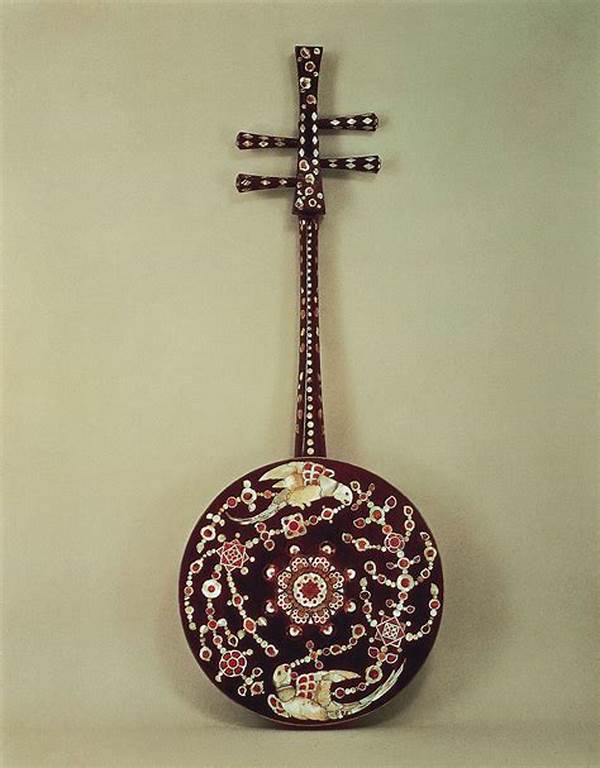In an era where every sound is tethered to technology, a journey back to the Tang Dynasty unfurls a world where celebrations were orchestrated with the authentic resonance of traditional Chinese musical instruments. Imagine standing in the opulent courts of the Tang Dynasty, surrounded by the gentle hum of silk strings, the profound echo of wooden percussion, and the ethereal whispers of bamboo flutes. These instruments were not mere tools of entertainment; they were integral to the cultural and celebratory fabric, echoing stories of valor, love, and traditions across time. The friendly embrace of these vintage sounds offers a stark contrast to today’s electronic melodies, enchanting those who dare to pause and listen.
Read More : Music Instrument With Futuristic Ai-driven Sound Compositions
Embarking on this melodious journey is like flipping through a photo album of sounds, each note a vibrant picture of the past, a past where music was an exclusive treat reserved for grand celebrations and sacred rites. The wealth of emotions evoked by these instruments is a testament to the innovative artistry of ancient craftsmen. It isn’t just the sounds but the stories behind each instrument that captivate modern audiences, inviting some to explore the richness of this heritage while others seek to preserve it.
The Role of Music in Tang Dynasty Celebrations
During the Tang Dynasty, music played a pivotal role in courtly celebrations and festivities. It was a period marked by cultural flourishing, with the capital Chang’an (modern-day Xi’an) serving as a vibrant hub of music and arts. Chinese traditional music instruments were an inseparable part of Tang events, weaving harmonic tapestries of sound that underscored ceremonies, banquets, and community gatherings. The musicians, though unseen to us now, were the invisible architects of emotional landscapes, guiding the hearts and minds of their audience with each melody.
The most revered instruments included the elegant pipa, a plucked string instrument known for its expressiveness and agility. There was also the guqin, a seven-string zither with a history steeped in lore, embodying philosophical and spiritual thoughts. The sheng, a mouth-blown free reed instrument, brought harmony and warmth through its symmetrical build and sonorous tones. Every celebration was incomplete without the accompaniment of these instruments, which narrated tales and conveyed sentiments beyond words.
Noteworthy Instruments and Their Impact
The Enchanting Pipa
The pipa, often referred to as the “Chinese lute,” was highly esteemed for its bright tone and versatility. This pear-shaped instrument mesmerized listeners with its dynamic range, rendering both lyrical ballads and rapid staccato passages. The pipa’s significance in Tang celebrations was both musical and symbolic, manifesting the court’s sophistication and cultural inclusivity as foreign melodies influenced its repertoire.
Resonance of the Guqin
Not to be outdone, the guqin held spiritual significance, representing the intellectual and artistic refinement of its player. Confucius once lauded the guqin as an instrument of contemplation and self-development. Its role in Tang celebrations was often more intimate and personal, touching the soul with its subtle timbre and nuanced vibrations.
The Harmonious Sheng
The sheng added a harmonious backdrop to the musical ensemble, its multi-pipe structure allowing for a rich blend of notes that enriched the festival atmosphere. Its design and sound served as metaphors for the balanced harmony sought after in Tang society—a harmony between people, nature, and the cosmos.
Discovering More about Tang Dynasty Instruments
To fully appreciate the grandeur of Tang Dynasty celebrations, one must understand the unique construction and playing techniques of their instruments. These are not just musical tools but vessels of ancient wisdom and cultural identity. Here’s a closer look at three remarkable instruments:
Read More : Musical Instrument Crafted From Recycled Materials For Sustainable Music
Understanding these instruments involves tracing their origins and influence on modern Chinese music, illustrating the interwoven tapestry of tradition and innovation that distinguishes Chinese musical heritage.
Embracing Tradition in Modern Times
In today’s fast-paced digital world, the allure of Chinese traditional music instruments from the Tang Dynasty is both nostalgic and refreshing. They offer a gateway into a transcendent soundscape where elegance and simplicity reign. As a cultural relic, they invite modern listeners to appreciate the profound artistry that has shaped the world’s musical heritage.
Educational endeavors and music festivals continue to highlight these instruments, ensuring their timeless nature resonates with future generations. From student orchestras to international collaborations, the legacy of Tang music endures, echoing through concert halls and classrooms.
Conclusion: A Timeless Melody
Connecting with the past through the hauntingly beautiful strains of Chinese traditional music instruments allows us to witness history in a tangible way. These sounds are a testimony to the cultural richness of the Tang Dynasty, offering insights into an era of grandeur and creativity. Each note serves as a reminder of the natural harmony and philosophical depth that defined a sublime period of human achievement. Embracing these traditions today not only honors history but enriches our present, fostering a deeper understanding of the universal language of music.
Embracing these instruments offers more than just auditory pleasure—it provides a visceral journey into a past where music was an identity’s heartbeat, exemplifying both the emotional and intellectual vibrancy of an era long gone yet never forgotten.
